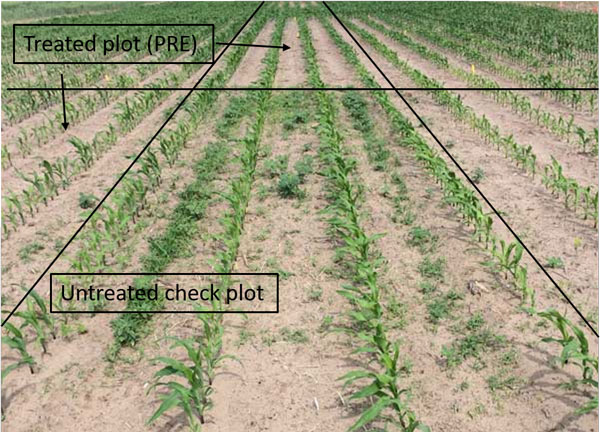Residual herbicides that kill weed seeds/seedlings as they germinate or emerge are an important component of herbicide applications at or before the time of corn planting. These herbicides can control weeds for several weeks, which prevents yield loss due to early-season weed competition and can greatly improve the effectiveness of a post-emergence herbicide application and give more flexibility for post-application timing. Residual herbicides are also an important component of sequential herbicide applications later in the growing season. In general, preventing the emergence of weeds, especially herbicide resistant weeds, is preferable to controlling them after they emerge (Figure 1).

Figure 1. The corn plot in the foreground received no pre-emergence herbicide. The plots adjacent to the untreated check received an application of pre-emergence herbicide. The photo was taken just prior to the prescribed post-emergence treatment in May 2018 at the Kansas River Valley Experiment Field in Rossville. Photo by Stu Duncan, K-State Research and Extension.
Many cases of herbicide-resistant weeds have resulted from over-reliance on post-emergence herbicide applications, thus it is essential to include one or more residual herbicides available for corn. However, it is also important to remember to change residual herbicides to prevent selection of tolerant or resistant weeds. The importance of this is reflected in the recent confirmation of waterhemp and Palmer amaranth that are resistant to S-metolachlor (Dual).
The specific herbicide you use is important, but it is usually less important than making the decision to use a residual herbicide program that includes at least two effective herbicides. But, it is important to know the strengths and weaknesses of each product in terms of the spectrum of weeds controlled. A table summarizing weed species response to various corn herbicides can be found on pages 24-26 of 2023 Chemical Weed Control for Field Crops, Pastures, Rangeland, and Noncropland (SRP 1162) at: https://www.bookstore.ksre.ksu.edu/pubs/SRP1176.pdf
Categories of residual herbicides for corn
Photosystem II Inhibitors (Group 5). Atrazine is the most widely used PS II inhibitor in corn. It controls a wide variety of broadleaf weeds, including pigweeds, ragweeds, morningglories, and mustards, as well as some grass species. However, atrazine resistance has been reported for many weed species. Atrazine use rates are influenced by soil type, soil pH, and organic matter, and use is prohibited in instances where water contamination is likely. Unless your situation prohibits atrazine use, it is recommended to include atrazine when you apply HPPD-inhibitor and acetamide herbicides.
Very Long Chain Fatty Acid Inhibitors (Group 15). The main VLCFA products used in corn include acetochlor, S-metolachlor, metolachlor, dimethamid-P, and pyroxasulfone In general, these products are very effective in controlling most annual grasses (except shattercane) and small-seeded broadleaf weeds such as pigweeds. They are much less effective in controlling kochia or large-seeded broadleaf weeds such as cocklebur, devilsclaw, morningglory, sunflower, and velvetleaf. An exception are those products containing pyroxasulfone. Though resistance to Group 15 herbicides have been reported in corn/soybean rotations in Illinois, there have been no cases of weed populations in Kansas developing resistance to the Group 15 herbicides to date.
Group 15 herbicides are most effective when applied with atrazine. In past years, often because of cost, reduced rates of these products were applied to help manage heavy summer annual grass pressure, then followed up with a good post-emergence herbicide program. With the increased occurrence of glyphosate- and other herbicide-resistant weeds, it is essential to use the full rates of these products in conjunction with a POST program.
HPPD-inhibitors (Group 27). Examples of HPPD-inhibitors are isoxaflutole (e.g. Balance Flexx) and mesotrione (e.g. Callisto and many generics). These products should be applied with atrazine. HPPD-inhibitors provide excellent for control of kochia, pigweeds, velvetleaf, and many other broadleaf weeds, as well as grasses. Corvus (thiencarbazone + isoxaflutole) will control shattercane and common sunflower better than Balance Flexx, provided the sunflower is not ALS-resistant. Keep in mind, products containing Balance should not be applied to coarse-textured soils when the water table is less than 25 feet below the soil surface. Balance Flexx does not provide adequate control of sunflower.
PPO-inhibitors (Group 14). Examples of PPO-inhibitors include flumioxazin (e.g. Valor) and saflufenacil (Sharpen). Herbicides containing flumiozaxin must be applied 7 to 30 days before corn planting. These herbicides provide excellent control of pigweeds; however, they are marginal on kochia. Fierce (flumioxazin + pyroxasulfone) will provide improved control of velvetleaf and kochia compared to Valor. The addition of atrazine will enhance kochia, pigweed, velvetleaf, and morningglory control, provided the populations are not triazine-resistant. Sharpen and Verdict (saflufenacil + dimethenamid-P) have excellent activity on pigweeds, kochia, and large-seeded broadleaf weeds. However, the length of residual activity can be shorter than other pre-emergence products when all are compared at full rates. Approximately 7 to 10 days of residual can be expected per 1 oz of Sharpen and 5 oz of Verdict.
ALS-inhibitors (Group 2). One example of a pre-emergence ALS-inhibitor used in corn is flumetsulam (Python), which only has broadleaf activity and provides good control of large-seeded broadleaf weeds such as cocklebur, sunflower, and velvetleaf, or the small-seeded common lambsquarters. Flumetsulam is also a component of Hornet, Stanza, SureStart II, and TripleFlex II. These products are especially effective for control of sunflower, along with cocklebur and velvetleaf, but less effective for morningglory control.
Rimsulfuron is another ALS-inhibiting herbicide that is a component of Basis Blend, Instigate, Prequel, Realm Q and Steadfast Q. Products with rimsulfuron will provide short residual control of grass and broadleaf weeds and should be used as a setup herbicide with a good post-emergence weed control program. If ALS-resistant broadleaf weeds are present, these ALS-containing herbicides often will be less effective.
The use of trade names is for clarity to readers and does not imply endorsement of a particular product, nor does exclusion imply non-approval. Always consult the herbicide label for the most current use requirements.
Sarah Lancaster, Extension Weed Science Specialist
slancaster@ksu.edu